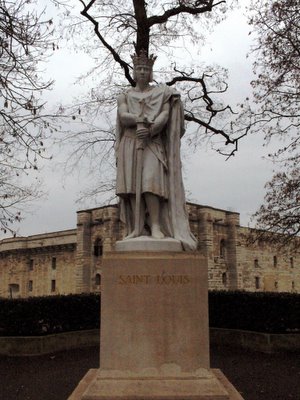
I wrote a very long blog entry, much of which contains book reviews of what I read during my lengthy travels. Before I get into that long boring stuff, I figured I will upload my photographs first since that is all most anybody wants to see anyway.
I am going to really test out the blogger photo hosting service by just uploading all of these directly to their site. When they got uploaded they were arranged in reverse chronological order; not that I think it is very important anyway. All of these photographs have higher resolution versions if you click on them.
This first picture is the last one I took on Sunday after my visit to Chateau de Vincennes. I tried going to the Pompidu centre and to the Grand Palace, but in both cases the lines were so long to get in that it wasn't practical. Instead I went the end of the metro line to Chateau de Vincennes and walked the grounds. The Church and the Castle are staggering. It would have been incredible to go inside but everything was all closed up. Here is the Wiki entry for it.
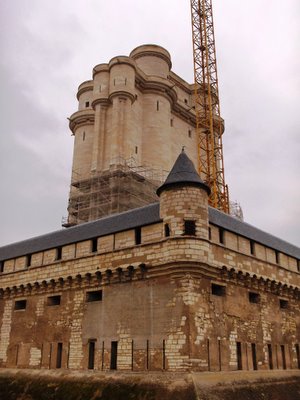
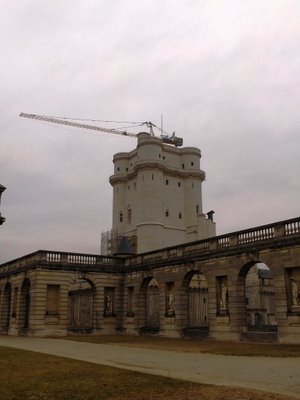
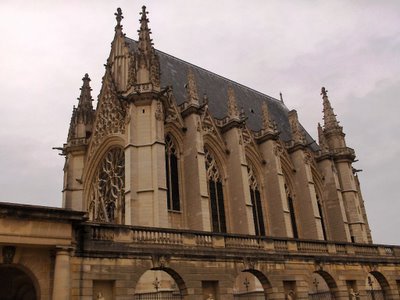 The Church at Chateu de Vincennes
The Church at Chateu de Vincennes
I hope this photograph can convey some sense of scale. Yes, that crane is the kind they use to work on skyscrapers!
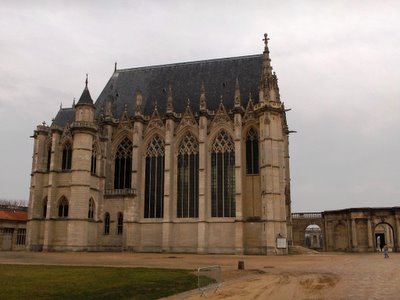
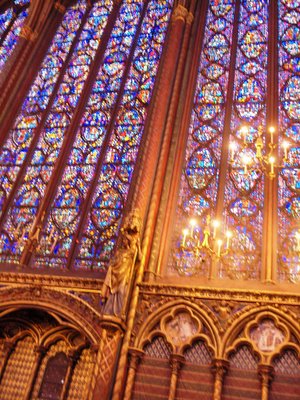 On Sunday morning I visited Saint Chapelle. It wasn't as impressive as I expected. Yes, the stained glass is beautiful, but other than that the chapel itself wasn't that impressive.
On Sunday morning I visited Saint Chapelle. It wasn't as impressive as I expected. Yes, the stained glass is beautiful, but other than that the chapel itself wasn't that impressive.
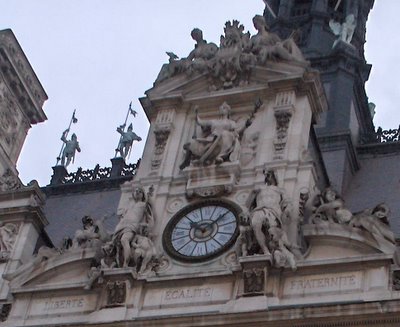 I snapped this photograph of Hotel Deville because I thought the slogan "Liberty, Equality, Fraternity" sounded very Masonic. Turns out, yes it is.
I snapped this photograph of Hotel Deville because I thought the slogan "Liberty, Equality, Fraternity" sounded very Masonic. Turns out, yes it is. On my previous trip I attended Mass at Saint Eustache and took a number of photographs. This time as I walked by I surprised to see that on the side of this great gothic cathedral were Roman columns.
On my previous trip I attended Mass at Saint Eustache and took a number of photographs. This time as I walked by I surprised to see that on the side of this great gothic cathedral were Roman columns.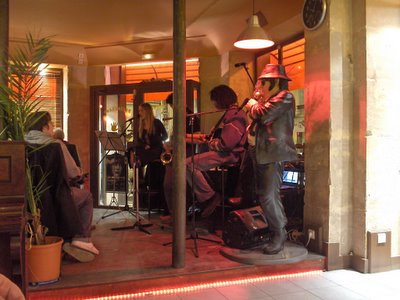 On Saturday evening after dinner I stopped by this bar across from my 'old' hotel. The owner greeted me very warmly. The bartender tried to speak to me in a bit of English and I felt very welcome in my little neighborhood bar. On another evening I made a point to have dinner there. While I was eating dinner a huge police van backed right up to the bar and many police men came pouring out and into the room. Suddenly everyone was kissing and hugging and the bartender ran outside into the police van to kiss everyone. It was a great slice of life moment in Paris. This Saturday evening there was a small Jazz band with a vocalist.
On Saturday evening after dinner I stopped by this bar across from my 'old' hotel. The owner greeted me very warmly. The bartender tried to speak to me in a bit of English and I felt very welcome in my little neighborhood bar. On another evening I made a point to have dinner there. While I was eating dinner a huge police van backed right up to the bar and many police men came pouring out and into the room. Suddenly everyone was kissing and hugging and the bartender ran outside into the police van to kiss everyone. It was a great slice of life moment in Paris. This Saturday evening there was a small Jazz band with a vocalist. The ceiling of Opera Garnier with its famous Chagall painting. Enterting the Opera staggers the senses. This modern painting blends so seamlessly into the more classical art it takes the breath away. I only regret I had my 'crappy' camera. My other camera takes excellent pictures in low-light conditions. Most of these did not turn out that great.
The ceiling of Opera Garnier with its famous Chagall painting. Enterting the Opera staggers the senses. This modern painting blends so seamlessly into the more classical art it takes the breath away. I only regret I had my 'crappy' camera. My other camera takes excellent pictures in low-light conditions. Most of these did not turn out that great.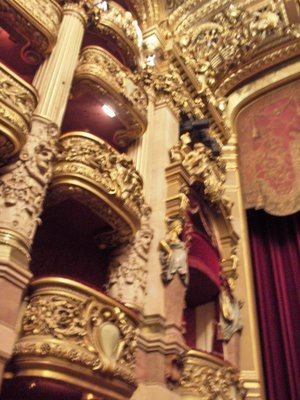 Some of the private box seats lining the walls.
Some of the private box seats lining the walls. Another photograph of the ceiling.
Another photograph of the ceiling. The grand hall.
The grand hall. I'm almost glad this photograph is blurry because I think it better conveys the sensation of mad color that exists in this room.
I'm almost glad this photograph is blurry because I think it better conveys the sensation of mad color that exists in this room. A shot straight up in the grand hall.
A shot straight up in the grand hall.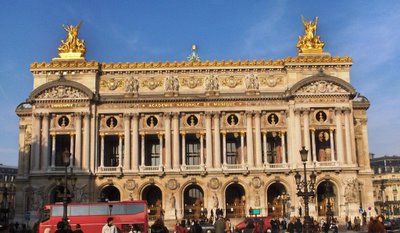 Opera Garnier exterior.
Opera Garnier exterior. A statue near the entrance of the theatre.
A statue near the entrance of the theatre.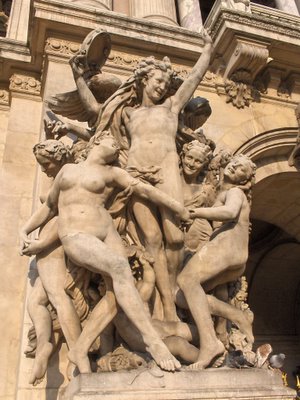 Another sculpture at Opera Garnier
Another sculpture at Opera Garnier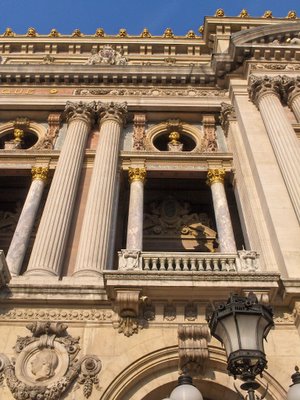 A view of the front of Opera Garnier which shows busts honoring famous composers.
A view of the front of Opera Garnier which shows busts honoring famous composers. A sculpture honoring the architect Garnier at the side of the Opera. This was the private entrance for the King.
A sculpture honoring the architect Garnier at the side of the Opera. This was the private entrance for the King.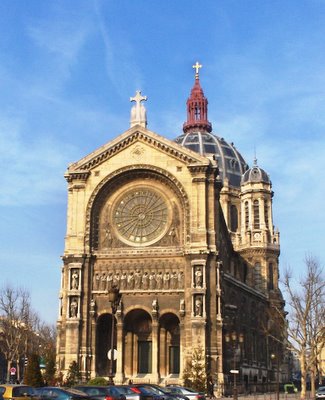 Saint Augustin, but it was closed and I coudln't go inside.
Saint Augustin, but it was closed and I coudln't go inside. Saint Augustin as seen from a distance, beckoning me to come visit its closed doors.
Saint Augustin as seen from a distance, beckoning me to come visit its closed doors.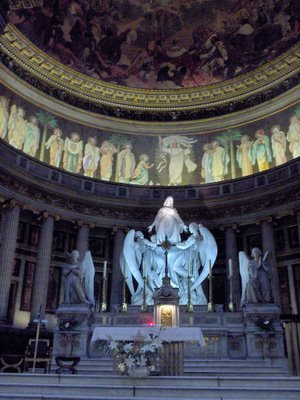 The interior of some famous church, but I forget its name right now. The exterior looked completely Roman and didn't appear obviously to be a Church at all.
The interior of some famous church, but I forget its name right now. The exterior looked completely Roman and didn't appear obviously to be a Church at all.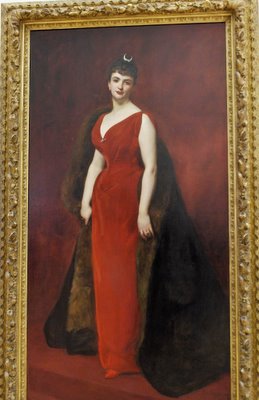 A painting at the Petit Palace.
A painting at the Petit Palace.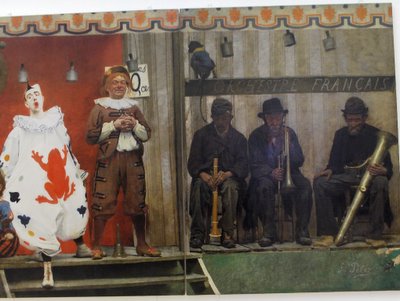 A portion of a very wide painting.
A portion of a very wide painting.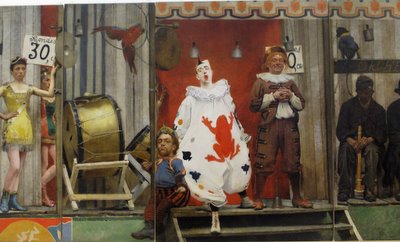 The middle of the same.
The middle of the same. The left side of the painting.
The left side of the painting. An incredible sculpture.
An incredible sculpture.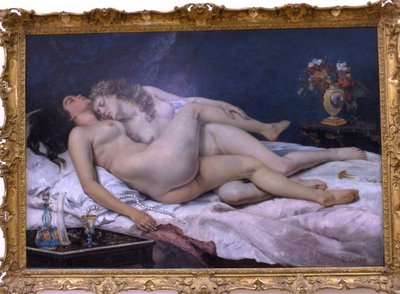 Hmmm..what were those French thinking? Girls gone wild in the 19th century?
Hmmm..what were those French thinking? Girls gone wild in the 19th century? One of the earliest examples of a near photorealistic painting style.
One of the earliest examples of a near photorealistic painting style. A damned old painting.
A damned old painting. I loved how colorful this painting was.
I loved how colorful this painting was. The full painting.
The full painting.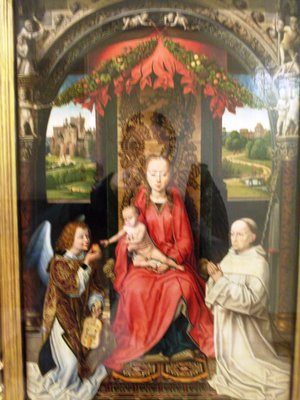 A very old annunciation.
A very old annunciation. Those monks had way too much time on their hands. I think this is carved of ivory. This is actually quite small. The detail is beyond belief. Across from this were hand painted manuscripts by Monks, equally as elaborate.
Those monks had way too much time on their hands. I think this is carved of ivory. This is actually quite small. The detail is beyond belief. Across from this were hand painted manuscripts by Monks, equally as elaborate.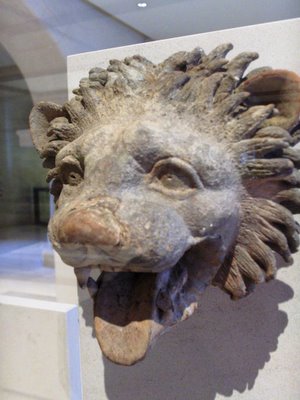 A greek sculpture.
A greek sculpture. Several Greek drinking horns.
Several Greek drinking horns.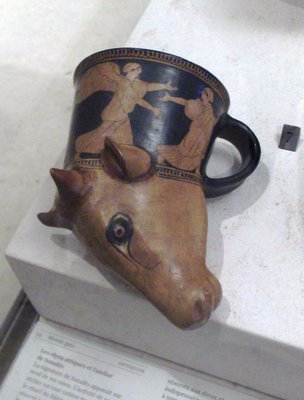

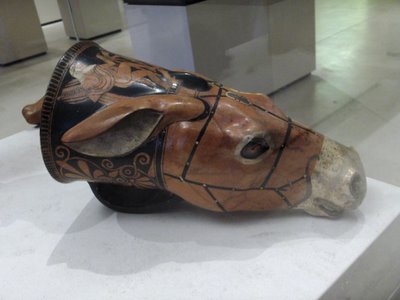
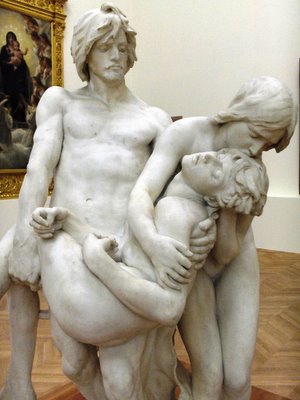 This statue is very powerful.
This statue is very powerful. A nice painting.
A nice painting.
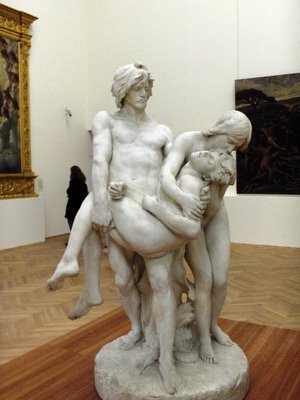 An asolutely stunning and powerful sculpture.
An asolutely stunning and powerful sculpture.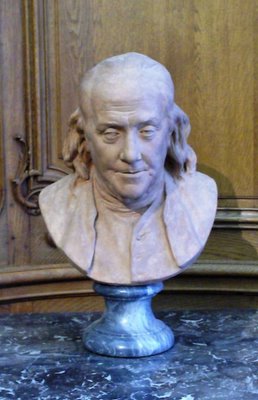 A bust of Right Worshipful Brother Benjamin Franklin inside the Petit Palace art museum.
A bust of Right Worshipful Brother Benjamin Franklin inside the Petit Palace art museum.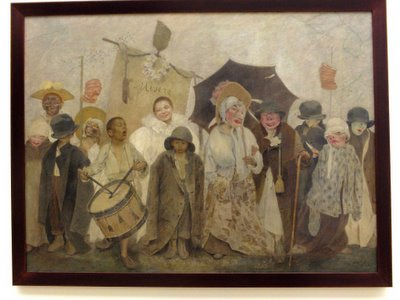 A painting I liked.
A painting I liked. Another painting in the Petit Palace
Another painting in the Petit Palace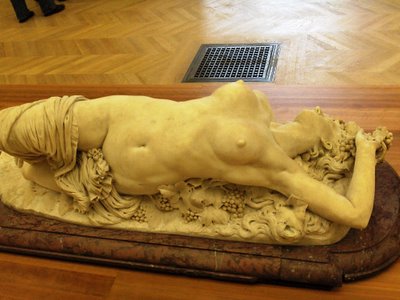 I think this might well be the most erotic piece of classical sculpture ever made.
I think this might well be the most erotic piece of classical sculpture ever made.
A painting I liked.
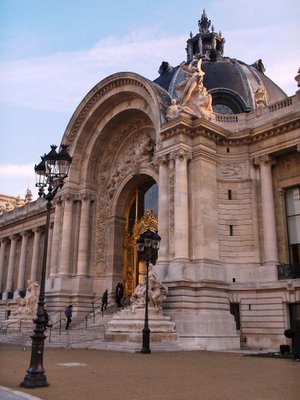 The front of the Petit Palace
The front of the Petit Palace The Petit Palace directly across the street from the Grand Palace.
The Petit Palace directly across the street from the Grand Palace.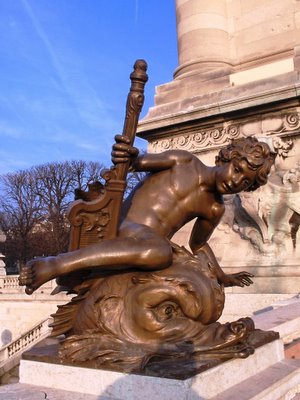
Some sculptures on a bridge near the Grand Palace.

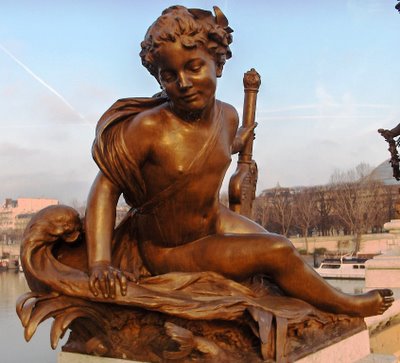
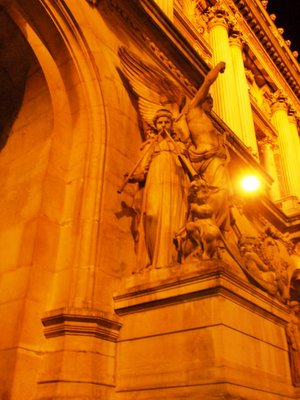
On the first evening I arrived I took the Metro to see Opera Garnier at night. I took some phtographs and here is one; a statue on one side.
Well, I’m back from Paris and trying to get readjusted. I have lots of bills to catch up on and things to do with my children. The trip was good from the perspective of the work I was sent out there to do. I didn’t get much time for sightseeing since I worked through the weekend. Since I worked from the late afternoon until the evening on Saturday and Sunday I did have the morning free at least.
I plan to make a lengthy blog entry today. It’s not so much for you the reader as it is for ‘me’ the reader. When I wrote my ‘year in review’ post I was really impressed at how a journal could help anchor memories in your mind. You know, memories all still ‘in there’ …….somewhere. They come leaking back very slowly. I know this because just the other day my wife found a video tape that was of me and my kids from about 19 years ago. I couldn’t remember anything on it. It was like I was looking at some other person’s family. Then, as I watched it, memories that I had entirely forgotten came slowly creeping back into my consciousness. Where were they all that time? I couldn’t have remembered one thing about the contents of that video tape until I actually saw it; and, even then, not right away. I honestly believe now that a journal is a powerful tool to aid in remembering your life. A private journal is nice, but a public one is even better in many respects. If you update it with photographs and thoughts, they help serve as important signposts in your life not only for yourself, but also your friends and family even when you are gone. Or, maybe I’m just completely narcissistic, I don’t know for sure but the truth is probably somewhere in between. You will note that I rarely talk about my job or my profession. This is because I like to retain a sort of separation of ‘church and state’ about the whole thing. My professional life is the business of my employer and not really anyone else. My personal life is what is most important to me anyway and is what I choose to remember. As for the job itself, it is seldom a spiritual endeavor. It is just more programming, the same thing I have done for twenty seven years. It has long since lost its novelty. I still enjoy it, and hope that I am still good at it, but it isn’t nearly as relevant as what I try to do in my personal life.
Speaking of memory, something mystical and magical finally happened in my Masonic work. I am able to memorize things. When I joined the organization I was quite concerned since much of what they do involves memory work. Since, like my friend John Oberschelp, I have an absolutely horrific memory I was concerned I wouldn’t be able to contribute in this aspect of Masonry. About a month ago I decided I would try to memorize one piece of Masonic ritual, called ‘the closing charge’. It is the most beautiful and inspiring piece we recite and I figured if I was going to memorize only one thing, then this would be it. I practiced it on my commute to work a couple of days and finally got it down. It is only one long paragraph of about eleven sentences. So, I didn’t know what that really proved. Anybody can memorize a paragraph and quickly forget it. What was remarkable was that I didn’t forget it! This made me wonder, can I memorize something else? So I did. And not only did I remember that one, bit it didn’t push the first one out of my head either. Since I recently joined Naphtali #25, and they often need people to sit in the chairs, I decided to try to memorize the entire opening and closing for every part. Except for one prayer, I have been able to memorize the entire thing. I find this completely remarkable. I’m still not entirely certain what value and benefit comes from memorizing ritual, but I’m pretty sure that it keeps the mind sharp. There are many retired brethren in the area lodges and, if you saw what they are capable of doing, you would be completely blown away. To hear an 90 year old man get up in front of a lodge and repeat a piece of ritual from memory, word perfect, that lasts for fifteen minutes in duration is a staggering feat to witness. If memorizing ritual can keep the mind that sharp as you grow older that that alone is a worthy reward for the effort invested.
For this trip to Europe I took a different route than I did the last one. The last two times I went to Europe I flew on Continental. Continental was fine, but they fly through Newark which is kind of a zoo where you have to pick up your luggage and recheck it for your next flight. On Expedia I rarely get a connection option with longer than an hour layover which just isn’t enough time to reach a connecting flight for an international trip. The biggest reason I wanted to avoid Continental this time is that their domestic flight is on these ridiculously tiny ‘express’ jets. It almost feels like flying in a prop plane it is so cramped.
For this trip I booked Delta to Atlanta and then Air France to Paris. I found out, after I booked, that Delta was bankrupt. Nevertheless, this didn’t seem to have any impact on the trip. Flying back my connection was through Chicago and the domestic portion was American Airlines. Re-checking baggage through Chicago was a lot smoother and I had more time to reach my connecting flight. I don’t think I will fly Air France again, though. Their seats are smaller than Continental and, though they pride themselves on their excellent food, there wasn’t much else to write home about. The biggest problem with Air France is that they don’t taxi to the terminal. We had to get off the plane and load onto busses. Getting onto the plane for the return trip was a zoo. Security was exceptionally tight and people were going through the boarding extremely slowly, each one tied up with extensive questioning, often extra security searches, and validation of documentation. Boarding took over an hour and half! Once through the terminal you, again, had to get on a bus, which drove so far we wondered if they were going to another airport entirely. The driver once had to slam on the brakes to avoid a collision and passengers were thrown about, luggage in tow, wildly.
I suppose I will try a different route entirely the next time, but I still refuse to fly west to go east. For whatever reason every time I look up flights to Europe on Expedia the most common connection offered is through Dallas. I don’t know, but I’m pretty sure the last time I looked on Google Earth that Dallas is about 650 miles in the wrong direction.
I tried staying at a different hotel this time. The last time, if you recall, the room was so tiny I (literally) could not lay one of my bags flat on the floor. It’s really confusing getting a sense of distance when booking a hotel on Expedia. I thought I had selected a hotel just a couple of blocks from the office, but it was a bit further than that. It was right at about one mile, which is a fair distance. I could have taken the Metro, but instead I walked to and from the office every day and, of course, walked quite a bit on Saturday and Sunday. It felt really good to get some minimum daily requirement of exercise. The hotel I stayed at was Le Patio St Antoine near Nation. It was so much nicer than the Comfort Hotel. It must be very lovely in the spring time. The room was large, had a small kitchen, pay TV, and a large bathroom with strong shower. I would highly recommend it though, one note of warning, their breakfast costs 18 euros, which is about $22; thanks but no thanks. I stuck to my normal Starbucks ‘café Americano’ and a muffin each morning.
As I have mentioned before, I am a voracious reader. However, I only read when I have a few hours or more completely undisturbed. In my life about the only time this ever happens is when I travel. Now, if I am going to travel internationally, this means I have a lot of time to read! Each time I take a trip I bring a whole library along with me. And, if I run out of books (which happened to me on this trip) I have several hundred downloaded on my Pocket PC.
So, I decided that I would post a brief bit of commentary about the books I read on this trip. Since I am paranoid about being pressed for time at the airport, I get there very early (typically two hours early for domestic and three hours early for international). Sure, that is a little excessive…sometimes. However, it sure makes you breathe a little easier when you encounter a line of hundreds of people filling a terminal or security checkpoint and know you have ‘plenty of time’. On the few occasions where I have been pressed for time, I get quite stressed. For a flight to Europe this gives me something like twelve to fourteen hours to read. That is a lot of time!
At the airport in St. Louis I went to a bookstore and selected a variety of books to read. I first grabbed the bestseller ‘1776’ which I have wanted to read for a while. I knew that just one book wasn’t going to be enough so I grabbed several others. I saved ‘1776’ for last, kind of like the ‘dessert’ for my literary banquet. Since I knew I had one really good serious book, I also grabbed some stuff written by whack-jobs to balance it out.
In the order I read them, here are my impressions.
“Mind into Matter : A New Alchemy of Science and Spirit” by Fred Alan Wolf, Phd.
To be fair I didn’t so much read this book but rather ‘finished’ reading it. I had about the last one third of the book left and I wanted to get it out of the way. I have been reading Fred Alan Wolf on and off for a while. He’s kind of entertaining in a Timothy Leary sort of way. Fred Alan Wolf is one of those ‘physicists’ who took plenty of acid in the 60’s, and probably more later on.
This is the first book I have read by Wolf where he completely abandoned all pretense of being an objective scientific observer and just went whole hog into New Age mumbo jumbo. To be quite honest, I’m glad he did. It was refreshing for him to finally just come out and say what you know he has always believed. There is nothing particularly new in the book and it is generally a ‘stoopid’ read. The reason I still hadn’t finished it (it is a small book) is because I didn’t think it was all that good. However, the last part was actually the best part, and when he just goes off preaching at the end I quite enjoyed it.
“Secrets of the Widow’s Son : The Mysteries Surrounding the Sequel to the Da Vinci Code by David A. Shugarts”
My review of this book can be summed up in two words: "Mostly Harmless"The author previously wrote a book debunking the DaVinci code. He is clearly a parasite, making money off of the success of the DaVinci code books, so he treads a very thin line where he kind of sucks up to Dan Brown while 'gently' correcting his literary excess.This book is really strange, because it is a pre-emptive pre-bunking of an unpublished novel. He makes a lot of guesses as to what Dan Brown's next book might be about, and then tries to lay out the factual record ahead of time.He mostly talks about how Freemasons were involved in the American Revolution and the general architecture of Washington D.C. He doesn't seem to do this in either a positive or negative fashion, but is mostly just reporting facts. I can't see how there is anything really wrong with any of this. It is positive in the sense that he credits a lot of American Revolutionary heroes with being involved in the Fraternity. It is negative, in the sense that he doesn't say much about the Fraternity itself. Since he had a chance to talk on that topic, and he didn't, people may use their own imaginations about the motivations behind some of these men. If it is going to be a general trend in literature to credit Freemasonry with the American Revolution, hey, I have no problem with that. I have read a number of places on the internet that claim George Washington wasn't really all that 'into' Freemasonry. This is simply not true. And, there have been a number of biographies recently about Benjamin Franklin that make little to no mention of his involvement in Freemasonry. Since Freemasonry was a huge part of Franklin's life, this is clearly something that is worth reporting.I expect a lot of people to try to downplay the involvement of Freemasonry during the American Revolution, but I think that would be a mistake. Anyone who is an active Freemason knows how deeply interwoven the philosophy of the institution becomes in the whole of your life. There is no reason to imagine that it did not affect these men in a similar fashion. It seems reasonable to suggest that a lot of the principles of the craft did, in fact, find their way into the documents and ideas of the day. There is a pattern of identifying who 'was' a Freemason and who 'wasn't a Freemason' without recognizing that these were ideas that were gaining great traction with all of the revolutionaries. It is the ideas that matter, much more so than whether or not any particular individual was carrying a dues card at the time.The author does throw out a red-herring by suggesting there is some possible correlation between Dan Brown's new book and Mormonism. However, I would hardly consider Joseph Smith as having anything to do with Masonry beyond acting as a thief, stealing our ritual for his new religion.In summary, "Mostly Harmless"
“The Coming Global Superstorm : Are Bell & Whitley Strieber
Ok, so this was my ‘whack-job’ book. I saw it and grabbed it for a laugh. When I saw that it was a “New York Times bestseller” I figured I would satiate my curiosity and see what nonsense good old Strieber was peddling these days.
I had an interesting experience reading this book, primarily because I really enjoyed it. I will give Strieber credit, he can write. The book completely held my attention and I read it with great gusto. I was able to read it fast because I skipped the ‘fiction’ portion of the book. Throughout the book he interleaved a completely fictional account of the scenario he was laying out in his ‘so called’ non-fiction portion. I didn’t bother to read that crap. Then, about two thirds of the way through the book, I was enjoying it so much I went back and read the fictional part too.
Whoa, deja-vu, this was just like the movie “The Day After Tomorrow’, then whoa…of course, this is the book the movie was based on. I looked at the copyright date and saw that the book was written in 1999; roughly seven years ago!
It was then that I realized this was a ‘good book’. As you may, or may not know, there are some anomalies in history. There are a lot of books written on this material. For many years there was a ridiculous theory, proposed by John White (and others) called ‘pole-shift’. This is an absolutely ‘stoopid’ idea that has been rehashed in the wacko section of the bookstore for decades.
What Strieber does is retell the exact same material but, admittedly, with fairly easy flowing and entertaining prose. It is a nice narrative and easy to follow. When he gets closer to the end of the book he proposes a new theory. Instead of a ‘pole-shift’ he postulates that there have been ‘super-storms’. Today we are sort of getting used to seeing giant hurricanes on our satellite maps that engulf large portions of real-estate. Now, imagine that a hurricane was fed by an energy differential so large that it could produce a storm that would be nearly the size of an entire continent.
Strieber offers absolutely zero scientific evidence in support of this theory. In fact, he has no references in the book whatsoever. However, it is a good tale and imagining that a large storm could become…well..LARGER..is not nearly as insane as saying the crust of the earth shifts en-masse overnight.
What was interesting in his presentation was his prediction of a continued development of every larger and more dramatic storms in the future. Now, this book was written in 1999, and looking at just this past hurricane season, as well as the general trend since that time, and you have to give him credit. Whether or not a ‘super-storm’ is actually possible, there is no doubt storms have been trending bigger each year.
The book was much certainly better than I expected.
“The Messianic Legacy : Michael Baigent, Richard Leigh & Henry Lincoln”
I know, I shouldn’t have bought and read this book. Nevertheless, I did. I actually already own it and read most of it over ten years ago. I gave up then and, this time, I was determined to read the whole thing. Unlike Strieber, this thing is actually really well referenced. I mean, you can disagree with the conclusions of the authors (which I do) but there is a lot of ‘real’ information in these books.
In their first book “Holy Blood and Holy Grail” these jokers introduced the Priory of Sion hoax and the theory that the bloodline of Christ was actually the Holy Grail being preserved. Since then Dan Brown wrote the DaVinci code, repeating the exact same themes, and made himself an extraordinarily wealthy man. I heard something about Baigent and Leigh actually considering suing Dan Brown for stealing their ideas for his book, but I don’t see how that makes and sense. Here is a link to some crap about it.
Most of the end of this book is just brutally painful to read. It is so obvious that these authors have allowed themselves to be made the butt of a practical joke that it is painful to read their tortured logic for continuing the sham. Of course, the reason they push this tortured logic, is to sell books. Their first book made a lot of money and they had to keep pursuing this ridiculous theory even more to sell more snake oil.
The first part of the book talks about the historical Jesus. As I said, the book is well referenced and the authors actually do write well. I can recommend the book on that basis alone. The last part of the book talks about the Priory of Sion and this guy Plantard that used the authors for a practical joke.
There was one thing, however, that gave me pause. At the end of the book Plantard allegedly tells the authors the current goal of the secret society he is in. The current goal, he says, is to create a European Union with shared currency and economic ties.
Now, wait a minute I wonder.. Hasn’t that come true? What kind of a prediction is that I asked myself? So, I checked the copyright date on the book and it was written in 1989!? Now, I don’t know for sure, but it seems to me a bit interesting that the alleged member of this secret society stated the main goal of the organization (which supposedly does very long term planning) was the state of the world I find today. As I got off of the airplane and started spending my euro-dollars I figured Baigent and Leigh at least got one thing right.
“The Masters and the Path : C.W. Leadbeater”
I didn’t actually read this book, but I mention it because I *tried* to read it. When you attempt to have a well rounded library on Masonry you are going to end up with some strange books on your shelf. This character C.W. Leadbeater was a big time occultist during the whole theosophy movement. He hung out with Annie Besant, Madame Blavatsky and that crowd. I try to be open minded and I am always interested to read what people ‘think’ Freemasonry is really about. To C.W. Leadbeater, and some others, Masonry is an occult mystery tradition that works with and calls upon higher spiritual beings to help promote the cause of humanity. In this book Leadbeater tries to track down these ‘ascended masters’ and it very quickly becomes more drivel than I can stand.
Now that I have digested a massive number of Masonic books, as well as have a lot of direct experience in the organization, I am beginning to form some opinions on my own. There is a question; Is any part of Masonry actually ‘occult’ or is it instead that fringe-elements with some really bizarre belief systems have tried to attach their own personal agenda onto this ancient institution?
I think the latter is in fact the case. I can find nothing in Masonry that is occult in any way. It is simply what it is claims to be. A group of men joined in fraternity, trying to do good works independent of religious or political affiliation. It’s just not much more complicated that that. And, this small thing is remarkably a ‘big deal’. As we see mankind torn asunder by ancient hatreds, both political and religious, it is clear that this ‘old idea’ is just as important and relevant as it ever was. The fact that men like Leadbeater write books that associate the simple and clear principles of Masonry with their personal esoteric belief systems is not really doing the institution any great favors.
“The Meaning of Masonry : W.L. Wilmhurst”
I didn’t read this entire book on this trip because, well, I never read all of it. This book is based on a series of lectures given by W.L. Wilmhurst to various Masonic lodges during the first part of the 20th century. Wilmhurst suggests that there is a deeper spiritual meaning to the rituals and tradition of Masonry that goes beyond the surface value, but he doesn’t go nearly so far as authors such as Leadbeater. I often find his material incredibly inspirational. I read it again and again, and I feel like I learn more each time.
He does get a little bit ‘out there’ every now and then, talking about auras and psychic powers. That said, he is entitled to his own point of view and, for some reason, I find his writing much more pleasant to digest than Leadbeaters teleporting ascended masters.
“1776 : David McCullough”
As I said, I saved this book for dessert, and oh what a dessert it was! This book is simply awesome. It tells the story of the American Revolutionary war during the fateful year of 1776. It does so in a gripping way that makes you feel you are right inside of it. It is impeccably well researched and written, and makes frequent use of letters and private journals to get into the minds of the men who fought for this cause.
Even though the book is dense and fairly long (about 350 pages) it definitely ends too quickly. As soon as narrative of the year 1776 comes to end, so does the book. Which, I suppose, makes perfect sense but by this time you are so wrapped up in the story that you don’t want it to end there, especially right when it was getting really good! What McCullough details, is how amazing it is that the American Revolution survived past this year. The entire effort was almost completely destroyed many times over and it is almost unimaginable that the American Revolution continued and ultimately succeeded. Maybe everybody already knows this but, as I said, my memory sucks and this felt completely fresh and new to me. And, if you do already know it, the immediacy with which the author conveys the events and people involved will make it alive in your mind.
I do have a small quibble. Here we have a book that, to its credit, really tries to get inside the minds of the men involved in this great cause; especially George Washington and Nathanael Greene to name two. Now, here’s what I don’t quite get. How is it that he doesn’t think it is relevant to mention that these men were all Masonic brothers (as was virtually every general in the revolutionary war)? Often times when McCullough quotes correspondence between Washington and Hancock it is tinged strongly with the great ideas of Masonry which these men were fighting for. They were fighting not for the personal freedom for their country by clearly believed they were fighting for all of mankind, to create a nation based on the principles embodied in the craft. Yet, we have modern biographies of men such as Benjamin Franklin and Harry Truman that don’t even mention they were Freemasons!? How can this be?
It’s not like they were initiated in to a men’s club and then were never involved again. Franklin and Truman were both Grand Masters and no American was more involved in Masonry than Franklin. Perhaps for people who are unfamiliar with Masonry they fail to see how deeply it impresses its principles on the minds of its members. I will be the first to admit that if someone gets imitated and never shows back up to lodge again then, no, it might not be that big an influence in their lives. However, for the men of this time, when the entire concepts impressed in the Declaration of Independence and the Bill of Rights were based on Freemasonry I don’t think it is entirely fair.
Nevertheless, I just bought his biography on “Harry Truman”. I imagine I will get just as annoyed when he fails to mention that he was the Grand Master of the State of Missouri and had his offices in the same building where my lodge meets.
“The Builders : A Story and Study of Freemasonry by Joseph Fort Newton”
I have been reading this book in bits and spurts for a while now. It is on my Pocket PC and I read portions of it from time to time. When I finished “1776” I still had many hours of my flight left so I decided to, finally, read this book from beginning to end.
You don’t even have to buy this book; it is out of copyright and available online for free.
This ‘Builders’ is simply fantastic. The big take away I got from it this time was a clear understanding about how speculative Masonry evolved from operative Masonry. Most importantly was to understand that operative Masonry was always, and had every reason to be, a repository for spiritual teachings. First of all you have to realize that the basic ideas in Masonry are very old; as old as mankind itself. They have always been present in some form and often present in many forms and institutions. It is not always easy to connect perfect dots and say this led to that, or this thing became that thing. What you can say is there are some basic common principles and themes which have survived for thousands of years and became embodied in one form by the great cathedral builders of Europe. It was great to read this after having just returned from Paris. I attended Mass at Notre Dame on Sunday and visited a number of additional cathedrals built by these great artists. Some people confuse these cathedral builders with the run of the mill guild masons who might repair a wall in a village. Newton makes it clear these were entirely two classes. The most distinguishing characteristic of the operative Masons, besides their talent, was that they were ‘free-men’ allowed to travel from country to country.
The last couple of chapters of this book are very inspirational. For any Mason who is wondering to himself, what is this institution I have gotten myself involved in, you really must read this book.
That is the last book I read on this trip. And, now I probably won’t get to read anything until the next time I travel.
.jpg)
Comments